Pump Handbook by Igor J. Karassik, Joseph P. Messina, Paul Cooper, Charles C. Heald - 3rd edition
Подождите немного. Документ загружается.

7.2 CHAPTER SEVEN
CONTROLS _________________________________________________________
Pump control in the broadest sense gives the pump user (1) the flow rate, pressure or liq-
uid level desired, (2) protection for the pump and system against damage from the pumped
liquid, and (3) administrative freedom in decisions on operations and maintenance.
Control System Types Pump control systems range in complexity from single hand-
operated valves to highly advanced, automatic flow control or pump speed control systems.
Pump type and drive type are factors in control system choice. For centrifugal pumps,
either change of speed or change of valve setting can control the desired variable. For pos-
itive displacement pumps, whether reciprocating, rotary, screw, or other type, control is by
change in speed, change in setting of bypass valve, or change in displacement. The last-
mentioned method is found in metering and hydraulic drive pumps. Although this chap-
ter considers only control systems having valves as final control elements, the sensing
elements discussed also serve in pump speed control systems.
Pump control systems divide readily into two types: on-off and modulating. The on-off
system provides only two conditions: a given flow (or pressure) value or a zero value. A
valve is therefore either open or closed, and a pump driver is running or not. The modu-
lating system, on the other hand, adjusts valve setting or speed to the needs of the
moment. Either type of system can be automatic or manual.
System Essentials All control systems have
1. A sensing or measuring element
2. A means of comparing the measured value with a desired value
3. A final control element (a valve) to produce the needed change in the measured variable
4. An actuator to move the final control element to its desired position
5. Relaying or force-building means to enable a weak sensing signal to release enough
force to power the actuator
The sensing or measuring element is often physically separated from the comparison
and relaying means, which are usually housed together and called the controller. The actu-
ator and valve are physically connected and may be at a distance from the controller.
In a very simple control action, such as one based on an administrative decision to shut
down temporarily one of several small parallel pumps in service, some of the five essen-
tials may be supplied by the operator who turns the valve handwheels and pushes the
motor stop button. Nevertheless, the essentials must always be present in some form.
EFFECT OF RATE OF CHANGE The nature of the rate of change of the measured variable or
desired value with time gives a convenient guideline in pump control. The chief types of
change are
1. Slow change (practically steady state)
2. Sudden change from one steady state to another (either a nearly instantaneous step
change or a high-rate ramp change)
3. Fluctuation at varying rates and in varying amounts
Slow change involves questions of the ability of the control system to hold the desired
value accurately and not lag unnecessarily during the change. Equal accuracy when
approaching the new value from above or below is also desired.
Sudden change involves additional questions of whether the system will be excited into
amplification of some types of fluctuations and go totally out of control. Systems involving
fluctuation changes are the most difficult to design and operate; such factors as the iner-
tia of the control elements, amount of liquid in the system, and dynamic behavior of each
element and of the elements together must be considered.
OPEN-LOOP CONTROL The simplest mode of automatic control is open-loop control, in which
the pump speed (or displacement in some pump types) or the control valve setting is

7 PUMP CONTROLS AND VALVES 7.3
adjusted to and held at a desired value calculated or calibrated to produce the required
output of flow, level, or pressure. The calculation can result in a cam for the controller or
positioner or a particular characterization of a valve plug. In operation, only the deviation
of the input variable from its desired value is measured and the control system adjusts
the input variable to eliminate the deviation. Because the output variable is not measured,
a change in the conditions on which calculation or calibration was based will introduce
output errors. Change of input variable can be done manually or by another control sys-
tem. For example, a pump may be speeded up by a rheostat, or the air pressure to a valve
actuator may be changed by changing a pneumatic pressure control valve setting. Open-
loop systems are also called feedforward systems, in contrast to feedback, or closed-loop
systems. Open-loop systems are stable, simple, and quick in response, but they tend to err
as downstream conditions change.
CLOSED-LOOP CONTROL A closed-loop control system eliminates much of the error of the
open-loop system. In the basic closed-loop, or feedback, system, the output variable is mea-
sured and the value compared with an arbitrary desired or set value. If the comparison
reveals an error, the pump speed or control valve setting is changed to correct the error.
Large-capacity water tanks or lag in the control system can introduce delays in estab-
lishment of the new output value, and the system can therefore overcorrect and oscillate
back and forth unless design prevents this.
ON-OFF CONTROL The simplest closed-loop systems operate on-off between fixed limits,
such as water level or pressure. The on-off action is at the extremes of a wide or narrow
band that can be set at any point in the range. For example, a tank level control may work
in an on-off band of 1 in (2.54 cm) or 10 in (25.4 cm) at any level in a tank that is 5 ft (1.5
m) deep.
PROPORTIONAL CONTROL
This is the basic type of closed-loop control. Within a wide or nar-
row band of output variable values, the controller input, such as actuator air pressure, is
proportional to the deviation from the set point, or desired value, at the band center. If
the band is very narrow, for example, 1 in (2.54 cm) of level in a 60-in (1.5-m) tank, the
controller will apply full air pressure to the valve actuator at a -in (1.27-cm) deviation
from the set level in one direction and minimum air pressure at a -in (1.27-cm) devia-
tion in the other direction. This is close to the effect of an on-off control. If the band is
wider, say 20 in (50.8 cm) of level in the 60-in (1.5-m) tank, the air pressure will vary from
minimum to full pressure over the 20-in (50.8-cm) band and the system will be less sen-
sitive and apply less correction for a given small change in output variable.The lower sen-
sitivity can make the system less likely to overshoot or hunt. Because a given controller
output corresponds to every value of deviation from the set point, the simple proportional
system will not come back to its set point if the output variable changes as a result of
changed demand, such as for more water from the tank. The difference between set point
and actual new equilibrium value of level is called offset. Narrowing the band will reduce
the offset but may cause intolerable oscillations or hunting.
To improve response and stability and to achieve very high accuracy, however, several
refinements may be needed.Addition of reset to a simple proportional controller will elim-
inate offset. This is the proportional-plus-reset or proportional-plus-integral system. In
terms of the proportional band, reset means that the band is shifted in such a way as to
produce slightly more correction and return the output variable back to what is desired.
The reset feature may impair stability, however, because of the added control action.
Derivative action is an added refinement to improve stability and response. In this, the
rate of change of the measured output variable is what determines the controller output.
A step or sudden change in measured output variable will cause a momentary large
increase in controller output that will initiate response. When the derivative action fades,
the basic proportional-plus-reset action takes over to restore conditions.
The open-loop system, sensing a change in input variable and therefore giving rapid
response, is exploited by adding it to the closed-loop system. An example of a feedforward-
feedback system in pump flow control is the three-element boiler feedwater regulator.
1
2
1
2
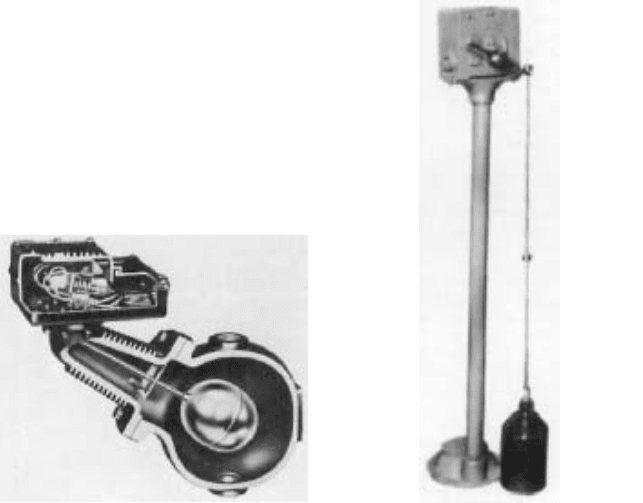
7.4 CHAPTER SEVEN
FIGURE 1 Low-water cutoff and alarm are purposes
of this liquid level sensor (McDonnell & Miller).
FIGURE 2 Adjustable tops on rod actuate lever arm
to tilt mercury switches as float moves (Autocon
Industries)
Sensing and Measuring Elements In automatic control of a pump, these elements
detect values of and changes in liquid level, pressure, flow rate, chemical concentration,
and temperature. The signal emitted by the element often needs amplification or conver-
sion to another medium, which is done in a transducer. Air pressure to electric voltage or
current and rotary motion to electric voltage are common transformations.
LIQUID-LEVEL SENSORS The simplest of several types of sensors is the float in the main tank
(or boiler drum) or in a separate float chamber connected at top and bottom to the tank
or drum (Figure 1). The float can be a pivoted type, with motion transmitted outside the
chamber by a small-diameter rotating shaft or translational rod attached to the lever arm
near its pivot to obtain mechanical advantage.A rod of the latter type can actuate the stem
of a balanced valve to control liquid flow and thus liquid level in the supplied tank.
Floats on vertical rods can actuate switches outside and above the float chamber (Fig-
ure 2). Depths can vary from less than 1 to more than 50 ft (0.3 to 15 m), with rod guides
often necessary at the greater depths. In some cases, the floats slide on the vertical rod
between adjustable stops. The floats then push upward or downward on the rod at the
desired control levels and trip the switch above. In a displacer-type arrangement for open
tanks, a ceramic displacer is suspended from one end of a stainless steel tape that passes
over a pulley and down again to a counterweight. The counterweight compensates for part
of the ceramic displacer weight, so it floats in the liquid. The extended pulley shaft drives
through a reducing gear to a shaft that carries mercury switches controlling as many as
four circuits (Figure 3).The gearing allows the displacer to travel as far as 30 ft (9 m), with
level adjustment between 2 and 27 ft (0.6 to 8 m). A weighted overcenter mechanism in the
switches gives quick make and break.
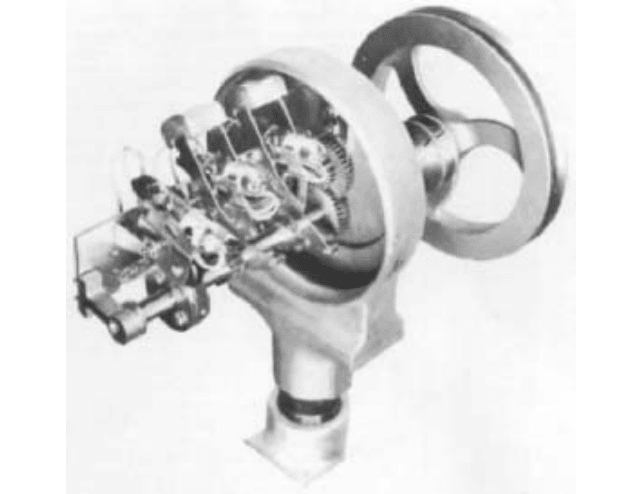
7 PUMP CONTROLS AND VALVES 7.5
FIGURE 3 Mercury switches in liquid level sensor head are tripped by adjustable cams (Autocon Industries).
*1 bar 10
5
Pa.
In other applications of the displacer, porcelain bodies on a cable are suspended from
the armature of a magnetic head control. In one form, a spring partly supports the weight
of the displacers. As liquid rises to the displacers in succession, their apparent weight
decreases and the spring can move the cable and armature upward to actuate snap-action
switches. The displacers can be moved up and down the cable to initiate action at the
desired levels. Three displacers can be mounted on a cable for such applications as one
pump actuated by the center displacer, a second pump by either the top or bottom dis-
placer, and an alarm by the third displacer. Displacers are advantageous for dirty or vis-
cous liquids that are still. Levels covered are from 1 to more than 10 ft (0.3 to 3 m).
The pulley shaft of the tape suspended displacer can also drive a potentiometer. The
potentiometer output can be applied to solid-state control equipment handling recording,
pump start and stop, and alarms.
The connection between float and switch need not be mechanical. An armature can be
attached to the top of the float rod sliding in a tube. Outside the nonmagnetic tube is
mounted the control switch, with a permanent magnet attached to it and set close to the
tube. When the level rises, the armature passes the permanent magnet and attracts it, so
the switch is actuated. A spring retracts the magnet when the level falls enough, and the
switch is reactuated.A float arrangement of this kind, although limited in range, finds use
as a low-water cutoff for boilers to 600 lb/in
2
(40 bar*) gage pressure. Switches are dry-
contact or mercury type. Two of these units can be placed at different levels to give both
high- and low-limit control.
Liquid level control systems without floats operate on several principles. If the liquid
is at all conductive, probes can be used. The electrode probes are fixed, usually mounted
in the same holder, and extend down into the tank (Figure 4). Two or three electrodes are

7.6 CHAPTER SEVEN
FIGURE 4 Electrodes
suspended on cables sense tank
water level below ice (B/W
Controls).
FIGURE 5 Induction relay: when liquid reaches pump start electrode,
current flows in secondary coil and diverts flux to lift armature and close
motor contacts (B/W Controls).
most common. Inductive or electronic relays are also part of the control system and actu-
ate pumps or valves.
In a tank filled by a pump, a drop-in level below the lower electrode breaks the circuit
to allow a relay to start a pump or open a valve. When the liquid rises to the high-level
electrode, the direct electric circuit between electrodes is established and a relay stops
the pump or closes the valve. In an induction relay (Figure 5), the line voltage is sepa-
rated from the control circuit by a primary and secondary coil arrangement. The relay
depends on the specific resistance of the liquid, which can vary from that of metallic cir-
cuits to that of demineralized water. Electronic relays have low potential and low elec-
trode current.
Fixed probes usually do not exceed 6 ft (1.8 m) in length, but suspension electrodes are
available for deeper tanks or higher level differences. Pressure-tight electrode holders
capable of operating at 10,000 lb/in
2
(690 bar) are available. Temperatures are generally
limited to 450°F (232°C). For tanks where icing is a problem, a pipe sleeve in which the
probes are suspended can be supplied (Figure 4).An immersion heater near the sleeve bot-
tom warms the water when the pump is not in operation.
Bubble sensors measure liquid level by determining the air pressure required to force
a small stream of air bubbles through the lower end of a tube extending to the bottom of
an open tank. The air flow tends to keep the tube and tube end clear in liquids that con-
tain solids. Floats and probes are eliminated in this method, and only the air flow regula-
tor and pressure switch are exposed to corrosive effects.The air stream flow rate can vary
over a range without affecting air pressure. The specific gravity of the liquid must be
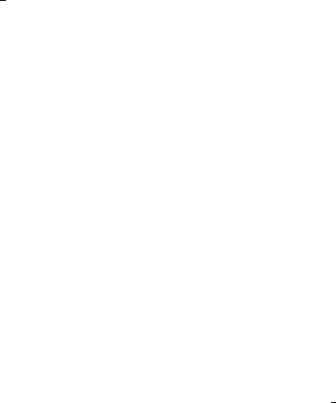
7 PUMP CONTROLS AND VALVES 7.7
known to allow the instrument to be calibrated. Because the measured variable is air pres-
sure, the other instrumentation can be set at distances of 250 ft (76 m) horizontally or ver-
tically. The range of liquid level is 6 in (15.2 cm) to about 32 ft (9.8 m). Sewage, industrial
processes, and water supply are some applications.
Notwithstanding the low air pressure involved, the differential sensitivity of pressure
switches for bubbler sensors is about 0.5% of maximum operating range.Air consumption
is about 1 ft
3
/hr (0.042 m
3
/h) when the air flow regulator is set for 60 to 80 bubbles/min.
The effects of air pressure failure can be prevented by providing a cylinder of carbon diox-
ide gas; a pressure switch and solenoid valve will introduce the gas to the system if the
compressor fails.
PRESSURE SENSORS Pressure controllers of the simple on-off variety may have a single-pole
double-throw mercury switch actuated by a bourdon tube. A typical differential value is
2% of maximum scale reading. Adjustment to desired cutin (low) pressure is made by a
knob on the case. Pressure ratings go to 5000 lb/in
2
(345 bar) for these devices. Propor-
tional control can be added to controllers of this type by incorporating a slidewire poten-
tiometer (Figure 6).
In other types of pressure sensors, one sensor is provided for pump start and one for
pump stop. Adjustable time delay prevents surging or waterhammer from giving a spuri-
ous start or stop signal. Increasing liquid pressure transmitted through tubing to an air
chamber acts on a bellows and, overcoming adjustable spring tension, trips a mercury
switch. The differential sensitivity of the bellows-type sensors is 0.5% of maximum oper-
ating range. Maximum pressure is about 175 lb/in
2
(12 bar) gage because the systems are
intended for use on open tanks. Sensors, timers, and relays can be mounted in a cabinet
located near the tank or even near the pump.
Air trapped in a bell and pressurized by rising water is the actuating mechanism for
another alarm switch (Figures 7 and 8). A synthetic rubber diaphragm in the switch body
mounted above the bell and connected to it by a small pipe is caused to tilt a mercury
switch and thus give the alarm. A rise in level of about 1 in (3.2 cm) above the bell mouth
will activate the switch.
ALTERNATORS
An alternator may be installed to achieve regular use and equal wear of
each pump in multipump installations. The simplest versions serve on two-pump systems,
but more advanced designs can rotate starting sequences of as many as 12 pumps. In one
version of the two-pump alternator, a solenoid plunger picks up and causes a four-pole
double-throw switch to take alternate positions, maintaining a position after the solenoid
is de-energized. If one pump leads with the other coming into service only to augment it,
the switching compensates accordingly.
If starting sequence is to be rotated for more than two pumps, a motor-driven rotor can
be advanced a given number of degrees each time a pump motor operates. The rotor con-
tacts are connected together in pairs to provide circuits between pairs of stator contacts.
Other control variations available in this regard are a change in sequence after a timed
interval and an option of starting the pump that has been idle longest and stopping the
pump that has run longest. Although many alternators operate on the same voltage as the
loads, variants are available for operation from the low voltage and current ratings of con-
trol equipment.
TRANSDUCERS AND TRANSMITTERS The variable that is most convenient or advantageous to
measure is rarely the one best suited for direct use in the control system or for actuation
of the final control element. A small differential pressure in a liquid level or flow control
system can scarcely open a large valve. Conversion of measured variable values to another
signal medium is therefore necessary and is the task of transducers and transmitters.
These two terms are used interchangeably to some extent, although the transducer usu-
ally converts a signal to an electric current and the output of the transmitter is usually
an air pressure.
A pressure-to-voltage transducer is especially useful in pump control. In one design, a
bellows subjected to the pressure of the liquid transmits force to a pivoted beam that
1
4
1
2
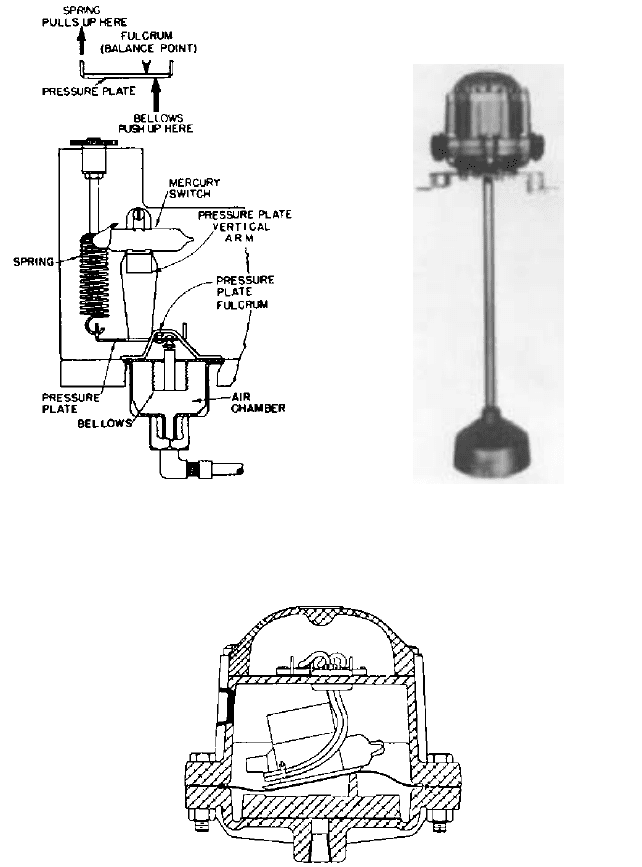
7.8 CHAPTER SEVEN
FIGURE 6 Pressure trip point is adjustable in this
pressure switch (Autocon Industries).
FIGURE 7 Alarm for level rise has bell connected to
switch mechanism by 1-ft (0.3-m) pipe (Autocon
Industries).
FIGURE 8 Switch assembly for level rise alarm (Autocon Industries)
moves a core in a differential transformer or motion transducer to produce a 3- to 5-V out-
put. The beam is balanced by a spring, and another spring allows the minimum pressure
for voltage output to be set, which is equivalent to zero suppression. Zero suppression here
can go as high as 95%.
Differential pressure transducers may operate on a force balance principle with a very
small motion of the bellows. The motion is converted to rotary motion in a ram or shaft,
7 PUMP CONTROLS AND VALVES 7.9
which then moves a differential transformer core to give an output signal that can vary
from 2.5 to 2.5 V dc.
A transmitter is a device that can sense pressure, temperature, flow, liquid level, or dif-
ferential pressure and convert the signal to a pneumatic pressure for transmission to
receiving instruments several hundred feet distant. The pressure-sensing transmitter can
span ranges to 80,000 lb/in
2
(5500 bar). The differential pressure type allows low differ-
ences in air or liquid pressures, such as a flow orifice develops, to be amplified through
linkage and force balance mechanisms. An air pressure of 3 to 15 lb/in
2
(0.2 to 1 bar) in the
air line from the transmitter is the result. Differential pressure transmitter designs are
available to withstand primary system pressures to 6000 lb/in
2
gage (400 bar), whereas
the differential pressures span ranges between 5 to 25 and 200 to 850 in (13 to 64 and 508
to 2160 cm) water.
TELEMETRY SYSTEMS When pump control must be exercised over distances greater than
the few hundred feet over which most pneumatic control equipment can operate, teleme-
try systems find application. In some of these systems, the sensor’s output is converted to
a proportionally variable 3- to 15-V dc voltage at the transmitter input. The transmitter
then converts the dc voltage to a square-wave pulse with duration varying in proportion
to the input signal. The resultant pulse width modulation (PWM) signal is sent directly
over transmission lines or via tone carrier in microwave, VHF, or UHF systems. Trans-
mitting the bipolar PWM signal alone requires direct wiring with less than 500 ohms
resistance. This means as much as 24 miles (37 km) on direct telephone lines. The PWM
signal eliminates loss of information from signal amplitude variations, and the bipolarity
of pulses reduces line capacitance effects.
With tone transmission, either amplitude modulation or frequency shift is used.
The receiver converts the pulse signal back to a variable 3- to 15-V dc signal identical
to the transmitter input signal and capable of use for indication or control. If transmission
is not received for a certain time period, an alarm can be actuated and the pumps started
or stopped.
Constant Speed Control Where pump speed control is economically justified, it is a
preferred method of obtaining the desired output parameter, such as flow rate, head, or
liquid level. If the pump operates at constant speed, there are four common control means:
1. On-off
2. Throttling by valve
3. Bypass by valve
4. Submergence
The on-off method with a single pump largely focuses on liquid level or temperature
range control. Centrifugal and positive displacement pumps can be controlled by this
method. If an accumulator is installed downstream, the method can be extended to head
control. With multiple pumps in parallel, flexibility is slightly greater and a coarse control
over flow rate is possible.
The simplest mechanism for on-off control of constant-speed pumps is the push button
switch and starter for across-the-line start of small pumps. For large pumps, reduced-
voltage starting is customary. Number of starts per hour is restricted in all cases to pre-
vent overheating.The electric impulse to start or stop the motor can originate in any of the
sensors or switches described above.
Throttling by valve is very common and can provide refined control under difficult con-
ditions where rapid response and outstanding dynamic stability are sought, as in boiler
feedwater control. Positive displacement pumps cannot use this method.
Bypass by valve is an occasional variation of valve control based on the bleedoff of dis-
charge liquid to reduce the flow rate at a downstream point or to allow a cooling flow to
pass through a constant-speed pump when its discharge has been blocked. The method
can serve both centrifugal and positive displacement pumps.
Submergence control, for centrifugal pumps, relies on a temporary decrease in avail-
able NPSH to reduce the pump flow rate to the value at which liquid is entering the sump
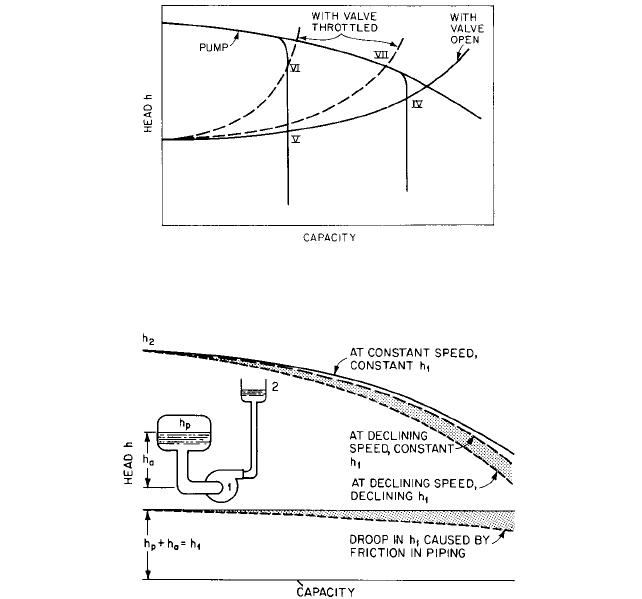
7.10 CHAPTER SEVEN
FIGURE 9 In submergence control, operation can be at points where restricted-capacity curve intersects piping
characteristic (IV, V, VI) or on regular pump characteristic (VII).
FIGURE 10 The centrifugal pump characteristics changes depending on speed and head at inlet.
(Figure 9).The method services for condensate, and design precautions prevent rapid cav-
itation damage.
VALVE-THROTTLING CONTROL The chief elements of centrifugal pump performance are
shown in Figure 10. At any given flow rate (capacity), a centrifugal pump produces a dis-
charge head consisting of the static head on the pump inlet and the dynamic head
imparted by the pump. At higher flow rates, speed usually declines slightly, lowering the
characteristic curve as shown. In addition, the higher flow rates produce more frictional
head loss in the inlet piping so the pump senses an inlet head slightly less than the sta-
tic head developed by the weight of the liquid column and the effect of compressed gas or
upstream pumps.
The pump can deliver any flow rate along the curve. What determines the actual flow
rate at any instant is the characteristic curve of the downstream piping (system curve), as
shown in Figure11. Under zero-flow conditions, there is a gravity head of liquid and per-
haps a pressure in a container, such as a boiler drum. When liquid flows, piping friction
head is added. Piping friction causes the system curve to turn upward, roughly paraboli-
cally. If a downstream control valve, previously wide open, is throttled, a new and more
rapidly rising system curve is established. The intersection of a pump curve and system
curve plotted on a single chart (Figure 12) indicates conditions at the pump discharge. The
combined plot also shows that the flow rate or discharge head will be modified by a change
in other parameters besides throttle valve setting. For example, an increase in pump speed
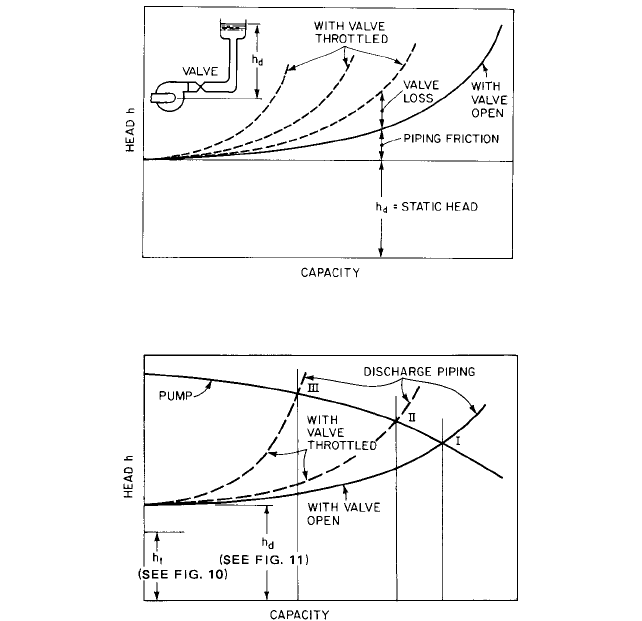
7 PUMP CONTROLS AND VALVES 7.11
FIGURE 11 Static head, piping friction, and valve loss determine the piping characteristic downstream of pump.
FIGURE 12 Intersection of combined pump and piping characteristics is operating point (I, II, III).
will lift the entire pump curve up and move the intersection point to higher flow rate and
head. Decreased pressure in a boiler drum will lower the entire system curve and move the
intersection point to higher flow rate and lower head. Throttling the inlet line to the pump
will reduce the inlet head and cause the pump curve to start at the same point, but slope
downward at a faster rate. The pump curve will then intersect the unchanged (down-
stream) system curve at lower head and flow rate.
BOILER FEEDWATER CONTROL In its original and simplest form, this control maintained the
water level in a boiler drum (Figure 13). Although this is still the primary objective in
many boilers, in other applications, a balance of steam flow rate against feedwater flow
rate is the primary objective, with level maintenance a secondary factor unless it exceeds
preset limits. In steam generators operating above the critical pressure of 3206 lb/in
2
(221
bar) abs, the feedwater turns to steam without a water level being visible, so temperature
and flow rates are the variables to be controlled.
Both on-off and modulating control are used in feedwater control systems. One classi-
fication of boiler feedwater control systems is based on whether the system is electric or
pneumatic. Another classification gives the number of variables sensed to determine con-
trol valve position: a single-element regulator senses water level alone, a two-element reg-
ulator also senses steam flow, and a three-element regulator adds feedwater flow sensing.
